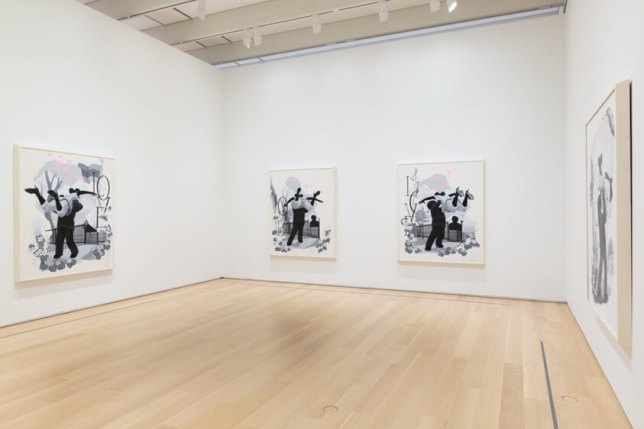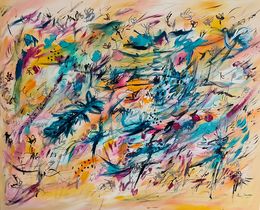
Artwork Analysis: Vignette (Wishing Well) by Kerry James Marshall

Kerry James Marshall is an African American artist, born in 1955 in Birmingham, Alabama. His works touch upon the issue of the under-representation of Black people in art history. In his series Vignette, Kerry James Marshall stages Black couples in scenes familiar to a Western audience. The result is striking and encourages reflection on the place of Black people in art history and in museums. Today, Artsper analyzes one of the works from this series: Vignette (Wishing Well).
Rethinking Rococo Art

In Vignette (Wishing Well), Kerry James Marshall invites us to rethink Rococo art. This artistic movement dating back to the early 18th century is known for its romanticism and frivolity. Rococo paintings often stage young lovers with pale skin and frilly dresses, seducing each other in bountiful gardens. The young girls are always taking part in some activity and surrounded by flowers. Often, they are observed by young men who, like voyeurs, admire from afar, turning them into objects of desire. In other words, the young girls in Rococo paintings are mostly here for a decorative purpose, like the greenery surrounding the scene.
Through Wishing Well, Kerry James Marshall confronts us with all these essential elements of Rococo. In a disinterested way, a young Black woman throws coins in a wishing well. The scene is surrounded, in a way that could not be less subtle, by pastel hearts and greenery. Hidden in the shadow of a tree, on the right side of the painting, one can catch a glimpse of a man; he seems to be playing the role of the voyeur. In this scene, Kerry James Marshall thus reuses the key elements of the Rococo movement. However, they are presented to us in an obvious, almost ironic way.
Normalizing Black presence in art
This way of reusing, almost mockingly, famous artistic norms is a strategy used by many artists. In particular, those that belong to minority groups use this method in order to challenge us. They invite us to rethink the way in which art history evolved; that is, in such a way as to highlight only white men and women. In 2019, a study showed that, out of the 18 biggest museums in America, 85% of artists exhibited were white and 87% were men. Additionally, African American artists were the least present. They only represented 1.2% of works, despite constituting a quarter of the population in the United States. A few years later, it is unlikely that a drastic change has occurred.
African American artists like Kerry James Marshall are thus often keen to normalize their presence in museums, but also to normalize Black figures in their works. Here, Kerry James Marshall chose Rococo art, a famously cheerful movement, known for its bright colors and its imaginary or utopic atmospheres. In the Rococo reappropriated by the artist, one does not really find this utopic aspect, apart from the pink hearts floating around. The figures in Wishing Well perfectly blend in with the darker surroundings chosen by the artist. We, therefore, find the same themes which clearly indicate the artistic movement chosen by Kerry James Marshall. However, these are slightly modified, in order to harmoniously include its two protagonists and get some distance from traditional western Rococo.
Vignettes: A series between political messaging and romantic light-heartedness

Wishing Well is one of the many works in the Vignettes series. Through it, the artist explicitly gets inspiration from scenes from Rococo, staging Black characters. In an interview for Art21, Kerry James Marshall explains where the inspiration for this series came from: “The work of African American artists has for a long time been seen more as a kind of social phenomena instead of aesthetic phenomena.” In other words, the works of African American artists are often, by default, understood or interpreted as being socially or politically motivated.
Although it is an important aspect for many artists, Kerry James Marshall attempts with his Vignettes to go beyond these interpretations. He thus places his figures in an apolitical and frivolous context. Indeed, the Rococo movement is known to be completely devoid of any political or intellectual message. The only thing that matters is the beauty of the romantic and joyful atmosphere.
His other vignettes always stage Black couples, but some of them include references to the history of political movements in the background. Vignette (Wishing Well) by Kerry James Marshall thus constitutes an in-between; the work is politicized by its inclusion of a Black couple in a historical 18th-century movement. But at the same time, it preserves its sentimentality and lightness. The artist uses the typical excess of Rococo while adding some nuance with black, grey, and white tones.
Transforming art for future generations
A subtle mix of seriousness and playfulness, Wishing Well is thought to be inspired by the famous romantic series by Jean-Honoré Fragonard, The Progress of Love. By finding inspiration in this iconic series, Kerry James Marshall shows the importance of proving that the beauty of romance can be found in Black love. That is, elsewhere than in what the majority of museums show us. Like the artist says himself: “If I don’t do it, or if other people like me don’t do it, we will be condemned to celebrate European beauty and accomplishments to perpetuity.”

About Artsper
Founded in 2013, Artsper is an online marketplace for contemporary art. Partnering with 1,800 professional art galleries around the world, it makes discovering and acquiring art accessible to all.
Learn more













